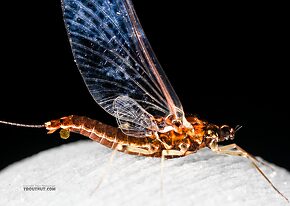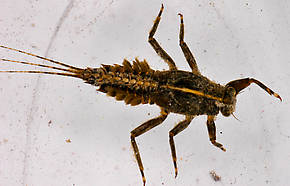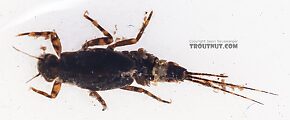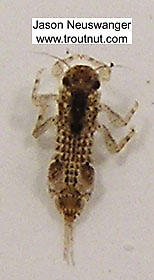Blog & Latest Updates
Fly Fishing Articles
Insects by Common Name


Mayfly Family Ephemerellidae (Hendricksons, Sulphurs, PMDs, BWOs)
Taxonomic Navigation -?-
Kingdom
Animalia (Animals)
» Phylum
Arthropoda (Arthropods)
» Class
Insecta (Insects)
» Order
Ephemeroptera (Mayflies)
» Family Ephemerellidae (Hendricksons, Sulphurs, PMDs, BWOs)
3 genera aren't included.
Common Name
| Match | Common Name |
| Hendricksons, Sulphurs, PMDs, BWOs |
This is page 27 of specimens of Ephemerellidae. Visit the main Ephemerellidae page for:
- The behavior and habitat of Ephemerellidae.
- 37 underwater pictures of Ephemerellidae.
Pictures of 271 Mayfly Specimens in the Family Ephemerellidae:
Female Ephemerellidae (Hendricksons, Sulphurs, PMDs, BWOs) Mayfly Spinner View 6 Pictures
View 6 Pictures
 View 6 Pictures
View 6 PicturesCollected August 1, 2020 from Mystery Creek #237 in Montana
Added to Troutnut.com by Troutnut on August 18, 2020
Added to Troutnut.com by Troutnut on August 18, 2020
Female Ephemerellidae (Hendricksons, Sulphurs, PMDs, BWOs) Mayfly Dun View 4 Pictures
View 4 Pictures
 View 4 Pictures
View 4 PicturesCollected August 4, 2004 from unknown in Wisconsin
Added to Troutnut.com by Troutnut on January 19, 2006
Added to Troutnut.com by Troutnut on January 19, 2006
Ephemerellidae (Hendricksons, Sulphurs, PMDs, BWOs) Mayfly Nymph View 3 PicturesThis is a really really really really tiny mayfly nymph. It has gills on abdominal segments 3-7 in the characteristic orientation for the Ephemerellidae family, and it has no fain tail as best I can tell, just uniform tail coverage with small black hairs of equal length. I think this one's too young to identify.
View 3 PicturesThis is a really really really really tiny mayfly nymph. It has gills on abdominal segments 3-7 in the characteristic orientation for the Ephemerellidae family, and it has no fain tail as best I can tell, just uniform tail coverage with small black hairs of equal length. I think this one's too young to identify.
 View 3 PicturesThis is a really really really really tiny mayfly nymph. It has gills on abdominal segments 3-7 in the characteristic orientation for the Ephemerellidae family, and it has no fain tail as best I can tell, just uniform tail coverage with small black hairs of equal length. I think this one's too young to identify.
View 3 PicturesThis is a really really really really tiny mayfly nymph. It has gills on abdominal segments 3-7 in the characteristic orientation for the Ephemerellidae family, and it has no fain tail as best I can tell, just uniform tail coverage with small black hairs of equal length. I think this one's too young to identify.Collected March 10, 2004 from unknown in Wisconsin
Added to Troutnut.com by Troutnut on January 19, 2006
Added to Troutnut.com by Troutnut on January 19, 2006
Drunella grandis (Western Green Drake) Mayfly Nymph View 2 Pictures
View 2 Pictures
 View 2 Pictures
View 2 PicturesCollected June 16, 2005 from the Vermillion River in Montana
Added to Troutnut.com by Bnewell on June 27, 2011
Added to Troutnut.com by Bnewell on June 27, 2011
Female Drunella flavilinea (Flav) Mayfly Dun View 6 PicturesI can't be certain of the ID of this female dun, but I'm calling it Drunella flavilinea for three reasons: 1) the known abundance of "flavs" on the Henry's Fork, 2) clear differences in coloration from my confirmed specimens of Drunella coloradensis, which is the main lookalike, and 3) the habitat (a sizable river in a wide mountain valley, rather than a small, high-altitude stream) suggests it's not coloradensis.
View 6 PicturesI can't be certain of the ID of this female dun, but I'm calling it Drunella flavilinea for three reasons: 1) the known abundance of "flavs" on the Henry's Fork, 2) clear differences in coloration from my confirmed specimens of Drunella coloradensis, which is the main lookalike, and 3) the habitat (a sizable river in a wide mountain valley, rather than a small, high-altitude stream) suggests it's not coloradensis.
 View 6 PicturesI can't be certain of the ID of this female dun, but I'm calling it Drunella flavilinea for three reasons: 1) the known abundance of "flavs" on the Henry's Fork, 2) clear differences in coloration from my confirmed specimens of Drunella coloradensis, which is the main lookalike, and 3) the habitat (a sizable river in a wide mountain valley, rather than a small, high-altitude stream) suggests it's not coloradensis.
View 6 PicturesI can't be certain of the ID of this female dun, but I'm calling it Drunella flavilinea for three reasons: 1) the known abundance of "flavs" on the Henry's Fork, 2) clear differences in coloration from my confirmed specimens of Drunella coloradensis, which is the main lookalike, and 3) the habitat (a sizable river in a wide mountain valley, rather than a small, high-altitude stream) suggests it's not coloradensis.Collected July 31, 2020 from the Henry's Fork of the Snake River in Idaho
Added to Troutnut.com by Troutnut on August 16, 2020
Added to Troutnut.com by Troutnut on August 16, 2020
Attenella margarita (Little Western Blue-Winged Olive) Mayfly Nymph View 7 PicturesNotes from the microscope on the ID: Maxillary palp (
View 7 PicturesNotes from the microscope on the ID: Maxillary palp ( Palp: A long, thin, often segmented appendage which can protrude from certain insect mouth parts such as the maxillae. Also known as the < />palpus.) is present, distinctly 2-segmented, but very small. Gills on segment 4-7. This specimen has some unfortunate damage to the abdomen, but it's the only one I found in my sample.
Palp: A long, thin, often segmented appendage which can protrude from certain insect mouth parts such as the maxillae. Also known as the < />palpus.) is present, distinctly 2-segmented, but very small. Gills on segment 4-7. This specimen has some unfortunate damage to the abdomen, but it's the only one I found in my sample.
 View 7 PicturesNotes from the microscope on the ID: Maxillary palp (
View 7 PicturesNotes from the microscope on the ID: Maxillary palp (
The palp on the maxilla of an Ephemerella nymph (detached and photographed under a microscope) is highlighted in red here.
Collected August 3, 2020 from the East Fork Big Lost River in Idaho
Added to Troutnut.com by Troutnut on August 19, 2020
Added to Troutnut.com by Troutnut on August 19, 2020
Eurylophella (Chocolate Duns) Mayfly Nymph View 2 PicturesIt has the segment 4 gill and abdominal segment 9 is longer than segment 8. I couldn't see abdominal tubercles (
View 2 PicturesIt has the segment 4 gill and abdominal segment 9 is longer than segment 8. I couldn't see abdominal tubercles ( Tubercle: Various peculiar little bumps or projections on an insect. Their character is important for the identification of many kinds of insects, such as the nymphs of Ephemerellidae mayflies.), but they may not yet be developed in such an early instar (Instar: Many invertebrates molt through dozens of progressively larger and better-developed stages as they grow. Each of these stages is known as an instar. Hard-bodied nymphs typically molt through more instars than soft-bodied larvae.).
Tubercle: Various peculiar little bumps or projections on an insect. Their character is important for the identification of many kinds of insects, such as the nymphs of Ephemerellidae mayflies.), but they may not yet be developed in such an early instar (Instar: Many invertebrates molt through dozens of progressively larger and better-developed stages as they grow. Each of these stages is known as an instar. Hard-bodied nymphs typically molt through more instars than soft-bodied larvae.).
 View 2 PicturesIt has the segment 4 gill and abdominal segment 9 is longer than segment 8. I couldn't see abdominal tubercles (
View 2 PicturesIt has the segment 4 gill and abdominal segment 9 is longer than segment 8. I couldn't see abdominal tubercles (
A few (not all) of the abdominal tubercles on this Ephemerella needhami nymph are circled. They are especially large in this species.
Collected March 10, 2004 from unknown in Wisconsin
Added to Troutnut.com by Troutnut on January 19, 2006
Added to Troutnut.com by Troutnut on January 19, 2006
Drunella coloradensis (Small Western Green Drake) Mayfly Nymph View 5 Pictures
View 5 Pictures
 View 5 Pictures
View 5 PicturesCollected July 28, 2019 from Mystery Creek #199 in Washington
Added to Troutnut.com by Troutnut on July 30, 2019
Added to Troutnut.com by Troutnut on July 30, 2019
Drunella coloradensis (Small Western Green Drake) Mayfly Nymph View 4 PicturesThis one nicely illustrates the variation in coloration within an single Ephemerellid species in a single stream, when compared to its darker, more uniform counterpart.
View 4 PicturesThis one nicely illustrates the variation in coloration within an single Ephemerellid species in a single stream, when compared to its darker, more uniform counterpart.
 View 4 PicturesThis one nicely illustrates the variation in coloration within an single Ephemerellid species in a single stream, when compared to its darker, more uniform counterpart.
View 4 PicturesThis one nicely illustrates the variation in coloration within an single Ephemerellid species in a single stream, when compared to its darker, more uniform counterpart.Collected July 25, 2019 from Mystery Creek #249 in Washington
Added to Troutnut.com by Troutnut on July 26, 2019
Added to Troutnut.com by Troutnut on July 26, 2019
Female Ephemerella excrucians (Pale Morning Dun) Mayfly Spinner View 6 Pictures
View 6 Pictures
 View 6 Pictures
View 6 PicturesCollected July 31, 2020 from the Henry's Fork of the Snake River in Idaho
Added to Troutnut.com by Troutnut on August 16, 2020
Added to Troutnut.com by Troutnut on August 16, 2020
Top 10 Fly Hatches
Top Gift Shop Designs
Eat mayflies.
Top Insect Specimens
Miscellaneous Sites
Troutnut.com is copyright © 2004-2024 Jason
Neuswanger (email Jason). See my FAQ for information about use of my images.
 privacy policy
privacy policy
